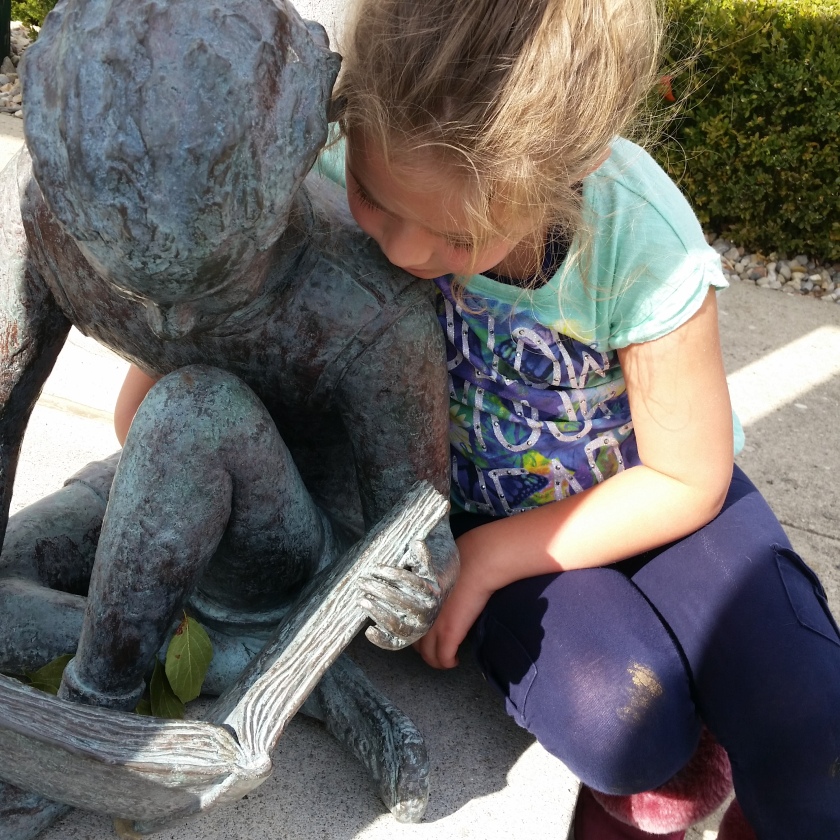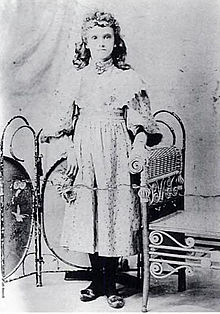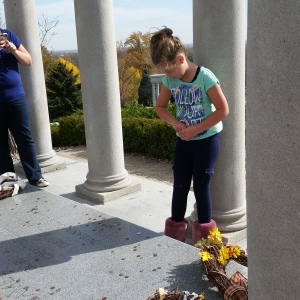
Taking kids to a cemetery for the first time can be a tricky business. I always wanted mine to visit their ancestors and loved ones, and I didn’t want them to be terrified and jumpy while they were there. I’ve always tried to put the emphasis on the grave markers as a way that we honor people, rather than a way to mark where their bodies are now.
Recently, I decided that my 1st grade granddaughter (I like to refer to her as Doll-baby) was old enough to be intro’d to leaf viewing at the graveyard with Grandmama. So, last week over her Fall Break from school, I resurrected (sorry, there are just too many terrible puns to resist on this topic) an old tradition from when her mommy was small. We loaded up the car, the dog, and ourselves and headed to the old city neighborhood surrounding Crown Hill Cemetery.
We passed through the ornate brick and iron entrance gates and drove by the Victorian era mourning station. For what seems like miles, the larger than life (haha) winged angels, obelisks, fancy tombs and little cave-like crypts are lined up in rolling winding rows. They look like randomly placed sculptures set in an outdoor gallery. The bleached white marble seemed to glow against a backdrop of red and gold maples.
Crown Hill is a big place. Covering over 550 acres, and currently just short of a quarter of a million interned, the cemetery has 25 miles of paved roads within it’s gates. With no road signs and so much to look at, it is an easy place to get lost in. To find the way to our destination (the famous “Strawberry Hill”) we follow a white line discreetly painted along one of the of narrow lanes winding through the graveyard.
The hill is the absolute best place I know of in Indianapolis for fall color viewing. It is unofficially the highest point in the city. From here, the view of the downtown skyline and all the rest of the panoramic scenery is breathtaking. And it ls from here that Mom begins her sneaky, slipped-in-before-they-notice-what’s-happening local history lesson. Doll-baby has expected to go trekking with crazy Grandma to see the pretty fall colors at the big city cemetery.
We are really there to soak up a little poetry and culture without getting spooked.
Here, scattered across the landscaped sections lie a US President, several “Veeps” all sorts of Senators and Ambassadors, a bunch of Union Generals, athletes, pillars of industry and society, gangsters (yep, over there that’s where ol’ John Dillenger is),the man who played Uncle Remus in Disney’s movie Song of the South, and even a Gypsy King and some race car drivers. It’s really quite the assortment at rest, eternally planted here together.
James Whitcomb Riley, Booth Tarkington, Kurt Vonnegut and that “Fault in our Stars” kid Augustus Waters are all buried here in our local cemetery (well, not Augustus really, he’s just a fictional character). I, like many of the “old timers” of Central Indiana, often refer to Crown Hill Cemetery merely as “out at 38th Street” and usually call the most swanky and coveted section of Crown Hill “Strawberry Hill.”
True, we are headed up the marked lane to see the city from it’s highest point, but we are also going to visit and leave a little gift for Mr Riley. It’s a tradition whenever you scale Strawberry Hill. And though I am not creeped out by graves and burial grounds, I sure would never want to get that way by snubbing tradition!
 Famous for his poem about goblins who would come and get misbehaving kids, Little Orphant Annie was a poem often read to children around Halloween– or bedtime when ill behavior warranted.
Famous for his poem about goblins who would come and get misbehaving kids, Little Orphant Annie was a poem often read to children around Halloween– or bedtime when ill behavior warranted.
Crowning Strawberry Hill, James Whitcomb Riley’s tomb has the best spot available out of every inch available in all of the massive cemetery.
“Annie” was a real girl who worked as a housekeeper and sort of nanny to the Riley children. She is pictured here in this photo from 1885. When her father went off to fight in the Civil War, her mother had already been dead for many years. When he was killed in action, little Annie was orphaned (or “orphant” in Hoosier talk). Her name in real life was actually Mary Alice, and the poem written about her was to be titled “Little Orphant Allie” but it was misread during typesetting and became famous instead as “Annie.”
Amazingly enough, Mary Alice wasn’t aware she was the inspiration for “Annie” for several years, or that James (or Jim as she knew him) had spent many years searching for her. He ran numerous ads in Indiana newspapers trying to find her and reconnect. In about 1915, just before his death, “Annie’s” daughter happened upon one of the advertisements and contacted him. You can read about it in Mary Allice’s obituary.
If you are unfamiliar, you can click on the poem’s title above if you’d like experience the sort of dark humor Mom was raised with. Those who are not at least partially fluent in “Hoosier” as a language will probably have a pretty tough time understanding the written words. So, for your convenience, enjoyment, and usage if you ever find yourself in need of a way to snap those pesky grandchildren in line…here’s an actual recording of Mr Riley, the old coot himself, reciting “Little Orphant Annie” around 1912.
The recording is also a bit tough to understand between the accent and the poet’s age when the recording was made, and likely his general condition. It seems that JW was an enthusiastic imbiber. So maybe he sounds a little slurry because he was a little sloshed?
I do recall times in my own childhood when by chance or by well planned attack, our Grandparents would somehow end up with all 9 of us grandchildren for the weekend. Occasionally things got a bit rowdy. I have flashbacks to scenes of our Grandpa (ol George the Methodist aka “The Dog Nab”) loudly reciting the lines of the Goblin poem in our direction. Then he would shew all of us, still white faced and breathless up the terrifying narrow stairway to our beds. In present times, this would probably be considered emotional abuse enough. However, the real abuse started when the snarling, howling gasps and whistling grunts started to waft up the steep stairwell as he slept denture-less and his snores crawled up from the master bedroom below us.
Sweet Jesus! We were all sure goblins and werewolves roamed those hallways at night!
We ended up having a wonderful and educational day. We gathered loose change up from the car and participated in the Riley Tomb tradition. Doll-baby thought that was really cool. Her class was always collecting soda tabs for “Riley.”
The tradition? Well it seems that although Mr Riley was widely known, well published and dearly loved by children and adults alike, he died completely broke. When the children of the city heard that their beloved spooky poem writing favorite was buried without a marker, they began coin drives until one could be purchased. Funds poured in from around the world and in 1922 the cornerstone was laid on the Riley Hospital for Children, in no small part funded by the coin drives of his young fans. Today, the Riley hospital is a beacon of hope for the sickest children from around the nation. And that’s why the tradition of leaving coins on his tomb lives on today, a hundred years after his passing. The grounds crew gather the money each day and deposit it into the Riley Children’s Fund.
Maybe those ol Goblins did more good than they could ever know!

The history of who’s buried there and where has always fascinated me. Good story about Riley, and what his life contributed to the town and children. My husband’s family was from Kentucky and Indiana and I have visited his relatives in both states. I have always wanted to know just what the word or term, ‘Hoosier’ meant. Do you know?
LikeLiked by 1 person
So there are books and arguments lobbed and families divided over the “what is a Hoosier” question at any and all family gathering involving people from Indiana. I should post about that 🙂
LikeLike
Definately. I would be one of the first to want to read it. 🙂
LikeLike
Perfect Halloween post.
LikeLiked by 1 person
Oh the Goblins gonna get ya if you don’t watch out!
LikeLike
I so wish my daughter didn’t believe in ghosts!! Cemeteries are such treasures – such a place to honor and remember those who’ve gone before us.
Another lovely, super-awesome post!
LikeLiked by 1 person
If she’s a Dillenger fan, drop her off with me if you swing thru Indy. We can make a day of it, and I can make her into a “convert! “
LikeLike
oh my, would she so love that!!! I may take you up on that offer, you know. She’s been itching to head out west and see this place Johnny called home.
LikeLike
This was such a great post! I loved it…and the traditions you’re sharing with “Doll-baby.” (And here I was thinking Dollbaby was a southern term only)
Strange as it may be, I run through a cemetery several times a week. I love studying the headstones for potential names I might use in a future story.. It’s not one as beautiful sounding as Crown Hill, but, grandparents and an aunt are buried in one that sounds similar. It’s called Oakwood, and is on the historic register. Like Crown Hill it is a place you could easily get lost because of the sheer size. The first thing I thought about when you said, 25 miles of paved road? What a great place to run!!! 🙂
LikeLike
When my kids were toddlers we lived in a remote area far from parks. We often took a picnic and walked to an ancient cemetery where they played and enjoyed every second, only knowing it as a beautiful spot. I hope resting there enjoyed their company as much as we enjoyed theirs.
LikeLiked by 2 people
I’ll bet they did!
LikeLike
Another delightful post. My mom often gathered her seven children — or all those who were at home — around her at night to read Little Orphan Annie, though she’d read it enough that she recited with great drama more than she read. We all knew the rhyme as well as she did, but were terrified every time. So I really appreciate all the background information on a poem I still carry around in my head.
LikeLiked by 1 person
Thanks Aunt Beulah!
I’m so glad that so many have also loved this poem. Maybe the comments here will help spur a resurgence in it’s popularity. Having the “dickens” scared out of you as a kid IS fun when it’s something like Annie’s warning to those who dare to misbehave! I think it was a good thing
LikeLike
I do so love your blog. What a great story, and a very lucky grandbaby to be taken on such an outing.
LikeLike
Thank you Pancho. I wonder what she will be writing about Grandmama some day? Some of this stuff must look different from her point of view. I hope I’ll be able to see it some day 🙂
LikeLiked by 1 person
This resonated on many levels… We grew up on visits to cemeteries, back in the 1950’s and 1960’s; they felt more like living history books than like spooky places…at least in broad sunlight. And Little Orphant Annie was a favorite of my mother’s; I was tickled several years ago to find a Dover edition of Reilly’s poetry with ‘Annie’ as the title read. I pull it out every Hallowe’en. I hope Doll Baby enjoyed her visit and has that kind of mystical, wonderful sense of the past her grandma clearly possesses!!!
LikeLiked by 1 person
She’s kind of my little side kick, which is fun. I’ve been on an eBay mission for a while to find an old edition printed here by Bobbs Merrill around 1909. Some day–some day 🙂
LikeLike
As an Australian, I had never heard of this poem. It was a pity for me and my children that we missed out on such a treasure, but I will be reciting it to my great-grand nieces and nephews, and any grandchildren I’m blessed with. You granddaughter is so lucky to have you!
LikeLiked by 1 person
Oh thank you Punky dear! Don’t recite it too enthusiastically or you’ll have them all in bed with you 🙂
LikeLiked by 1 person
Lovely post; as a lover of cemeteries, especially the old ones around me in London I enjoyed this walk through Crown Hill. Our best, known colloquially as the Magnificent Seven are wildlife havens now but the ghosts still roam happily too. Mind you, being of a certain age and British, to me Strawberry Fields recall the Beatles song, inspired by an orphanage in Liverpool. a strange connection given the story about Orphant Annie!
LikeLiked by 1 person
That’s amazing Tan. I never knew the song was about an orphanage! I always catch myself humming that song while heading up that hill. It’s one of those steep inclines where it’s hard to see the road with the car hood in the way!
LikeLike
Lennon played in the grounds as a child
LikeLiked by 1 person
The goblins gonna get you if you don’t watch out—was part of my upbringing as well. My mother loved riley’s poetry so often read it. I did the same with my kids. Great memories triggered by your blog. Thanks Lois
LikeLiked by 1 person